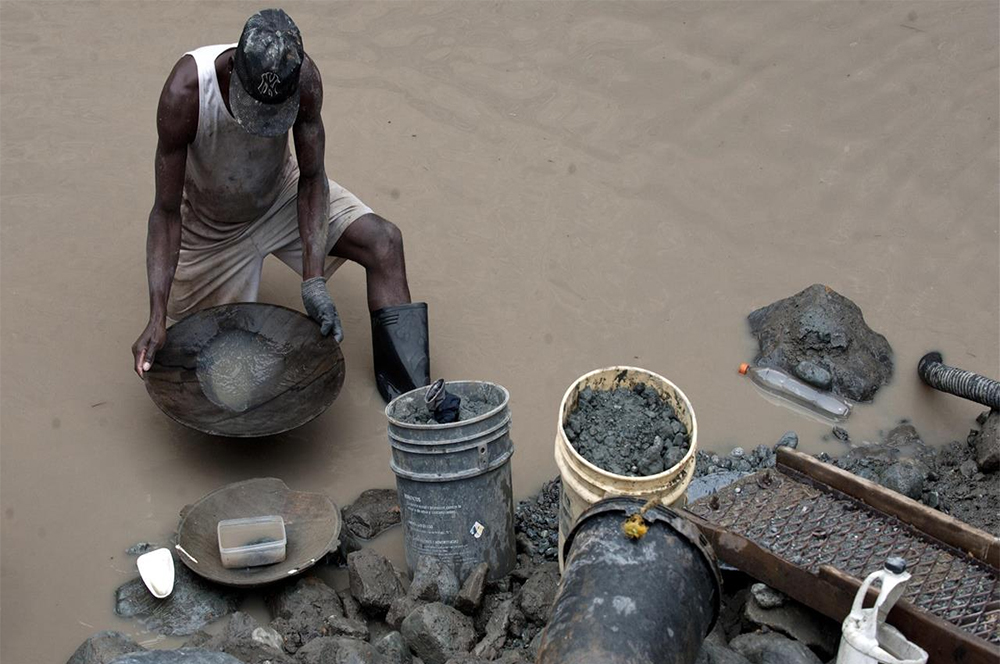Efrain Oliveros wants to show what he keeps tucked deep in his wallet for good luck as he motors around the hills of Buenos Aires, a gold-mining town in the Cauca Department of western Colombia. He carefully unwraps a baggy to reveal a tiny flake of green gold mined with a simple process — scooping up streambed gravel with a wooden pan and sifting it to reveal the precious metal. Until about 10 years ago, all gold was mined in this age-old way in Cauca, says the 27-year-old social activist, who asked that his real name not be used because of the frequency of attacks on advocates by armed groups in Colombia.
Half of Buenos Aires’ economy currently depends on mining, except that nowadays most artisanal and small-scale mines mix mercury with gold-bearing material into a mercury-gold amalgam that’s heated. The mercury vaporizes, leaving behind the ore. Miners and their families inhale the mercury vapors or absorb the metal through their skin — not good. The miners work “without gloves or any kind of protection,” Oliveros says. “It’s totally unregulated and out of control.” He and his 26-year-old wife tell OZY they only recently learned about the potentially devastating health threats posed by this silver liquid metal, and now they’re scared.
COLOMBIA’S PRESIDENT CALLED MINING ONE OF THE ECONOMY’S LOCOMOTIVES. IF SO, A LOCAL BUENOS AIRES OFFICIAL TELLS OZY, IT’S “A LOCOMOTIVE GONE OFF THE RAILS.”
They should be. If you’ve heard of Britain’s 19th-century mad hatter disease, you have some grasp of the dimensions of mercury poisoning: tremors, confusion, erectile dysfunction, birth defects, delirium, paranoia, memory loss and, at high enough levels, death.
Last year, the Colombian government released a report that documented 1,126 cases of mercury poisoning from 2013 to 2015. In the 2013–14 period alone, the number of documented cases jumped 770 percent. Four physicians and toxicologists consulted by OZY all insist that the studies are underfunded, limited in reach and fail to capture the full scope of the crisis. Toxicologist Federico Molina says that in some of the most contaminated mining towns in the Antioquia Department in northwest Colombia, mercury levels in urine samples are 300 percent to 400 percent above the permitted level. “If the government doesn’t do something about this [problem], we’re likely going to see an increase in cases,” Molina says.
The looming mercury poisoning disaster in Colombia arises out of a combination of poverty, poor regulations and armed conflict. Refining gold with mercury dates back to Roman times and has been used in Colombia for more than a century. But in the 1990s, miners started using the metal on an industrial scale with few — if any — safety precautions in place. By the mid-2000s, mercury was the norm. It was all due to a seemingly unrelated development: The U.S.-backed war on drugs had begun cutting into the profits of armed criminal gangs who had grown rich on cocaine exports.
So they did what any smart businesspeople would do: They diversified into an export they could sell legitimately on global markets: number 79 on the periodic table of elements. In 2008, when Oliveros remembers mercury first showing up in Cauca, gold traded for around $800 per ounce. Three years later, prices had soared to around $1,900 per ounce. In 2016 Colombia’s gold sales totaled $1.5 billion, nearly double the amount 10 years earlier.
As business boomed, so did the demand for mercury. Colombia’s government estimates that, in 2012 alone, miners used between 130 and 460 metric tons of mercury; the military figures that each year about 200 tons of mercury end up in the country’s rivers. It’s difficult to get an accurate figure, though, when the government estimates that 87 percent of gold mines in Colombia don’t have government-issued environmental licenses.
Oliveros and others from Cauca say that before criminal groups showed up in their village, gold mining was purely artisanal with no mercury additive. He thinks the criminal groups who started mining illegally in Antioquia, farther north, are the ones who are running the show down in Cauca. Today, about 16,000 people in Buenos Aires are using the heavy metal in ways that are hazardous to their health. Early in his term, Colombia’s President Juan Manuel Santos called mining one of the economy’s locomotives. If so, a local Buenos Aires official tells OZY, it’s “a locomotive gone off the rails.”
In 2014, the Santos administration pledged to get rid of mercury-based gold mining by 2018. But when most of the gold mines in the country are informal — or worse, illegal and operated by violent criminal enterprises — that’s difficult to do. The military is at it, though, forming a special 500-troop anti-illegal mining unit in December 2015. When the unit spots an unregistered jungle mine from a helicopter, they raid the site and blow up dredgers, excavators and other machinery.
Public health spending, on the other hand, seems impotent. Carlos Quiroz, a medical doctor and occupational health specialist at the University of Antioquia, says that his region used to have a free public mercury testing and treatment program, but five years ago it ended. “Why?” he asks rhetorically. “We have no idea.”
Treatment does exist in Colombia. Most rural miners who want to get tested spend two days and about $100 — nearly half of their monthly salary — to take a bus for hours to a major city so they can access a doctor and get the test. When contacted by phone and asked how difficult that is for the rural poor who work Colombia’s gold mines, Quiroz’s voice gets heavy: “It’s very difficult for them to find the means.”

